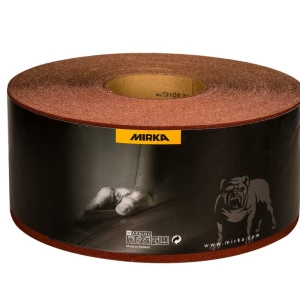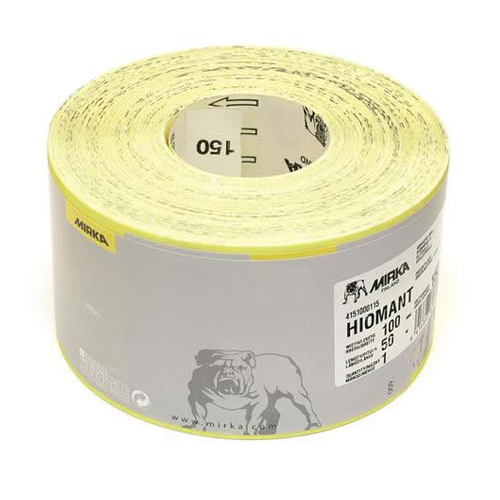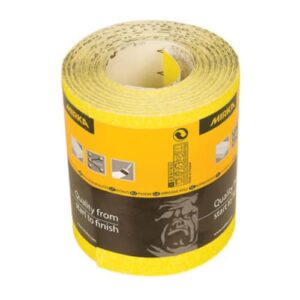Sand Paper
Sand paper is highly useful abrasive as it allows you to smoothen and even out surfaces so they are prepared for decorating. We have an outstanding range of sanding paper available here at Fosseway Tapes in a wide variety of sizes, grits and styles to fit your individual needs. So, whether you require abrasive paper for light sanding or more heavy-duty jobs, we have got you covered with our collection.
Showing all 10 results
-

Mirka Abranet Grip Strips 70mm x 198mm (50 Replacement Sanding Strips)
£30.49 Inc. VAT Select options This product has multiple variants. The options may be chosen on the product page -

Mirka Abranet Sanding Strips 70mm x 125mm – Pack of 50 Mesh Sheets
From: £19.69 Inc. VAT Select options This product has multiple variants. The options may be chosen on the product page -

Mirka Avomax Antistatic Abrasive Rolls 115mm x 50m – Wood & Paint Abrasive
From: £28.49 Inc. VAT Select options This product has multiple variants. The options may be chosen on the product page -

Mirka Avomax Plus Roll 115mm x 5m – Wood & Paint Sanding
From: £4.79 Inc. VAT Select options This product has multiple variants. The options may be chosen on the product page -

Mirka Basecut Abrasive Rolls 115mm x 50m
From: £29.39 Inc. VAT Select options This product has multiple variants. The options may be chosen on the product page -

Mirka Carat Flex Abrasive Roll 115mm x 5m
£5.40 Inc. VAT Select options This product has multiple variants. The options may be chosen on the product page -

Mirka Carat Flex Abrasive Rolls 115mm x 50m – Fine Finish Abrasive
From: £31.46 Inc. VAT Select options This product has multiple variants. The options may be chosen on the product page -

Mirka Hiomant Roll 115mm x 50m – General Purpose Abrasive
From: £29.99 Inc. VAT Select options This product has multiple variants. The options may be chosen on the product page -

Mirka Hiomant Yellow Abrasive Roll 115mm x 10mtrs
From: £12.71 Inc. VAT Select options This product has multiple variants. The options may be chosen on the product page -

Trend Jointing Biscuits 00/10/20 (1,000 Pack)
£35.50 Inc. VAT Select options This product has multiple variants. The options may be chosen on the product page
Abrasive Paper
We understand that different grades of sand paper sheets are required to complete different applications, so we have carefully selected our stock to meet your requirements. In our selection you will only find top brands such as Mirka, so you can rest assured that exceptional performance and quality is guaranteed with every product. Browse our sand paper range in full to take advantage of the fantastic prices and deals on offer online. Alternatively, if you have further queries concerning our abrasive sheets, don’t hesitate to contact us today.
Sandpaper is an essential tool for many DIY and professional projects. It’s used to smooth, shape, and remove material from various surfaces, including wood, metal, and plastic. Sandpaper is made of abrasive particles bonded to a paper or cloth backing, and it comes in a range of grit sizes and types.
Grit Sizes
The grit size of sandpaper refers to the size of the abrasive particles on the paper or cloth backing. The higher the grit number, the finer the abrasive particles and the smoother the finish. Here are the most common grit sizes for sandpaper:
- Coarse: 40-60 grit
- Medium: 80-120 grit
- Fine: 150-180 grit
- Very fine: 220-240 grit
- Super fine: 320-400 grit
- Ultra fine: 600-1500 grit
When selecting sandpaper, consider the level of surface roughness you need. If you need to remove a lot of material quickly, choose a coarse grit. If you need a smoother finish, go for a higher grit.
How do I choose the right type of sandpaper?
When choosing sandpaper, consider the material you’ll be working with, the level of surface roughness you need, and the type of project you’re working on. Different types of sandpaper are designed for different materials and purposes.
How do I use sandpaper?
To use sandpaper, attach it to a sanding block or use your hand to hold it. Apply light pressure and use long, even strokes to sand the surface. For wood projects, sand in the direction of the grain. For metal and plastic projects, use a circular motion to ensure an even finish.
How do I clean sandpaper?
Sandpaper can be cleaned by tapping it against a hard surface to remove the loose material. You can also use a rubber eraser to remove clogged material. If the sandpaper is still clogged, you may need to replace it.
Can I use sandpaper to remove scratches from my car?
Sandpaper can be used to remove scratches from your car, but it’s a delicate process and can easily damage the paint if not done correctly. It’s recommended to seek professional help for this task.
Can I use sandpaper on delicate surfaces like glass or porcelain?
Sandpaper can be used on delicate surfaces like glass or porcelain, but it’s important to use a very fine grit and be extremely careful not to scratch or damage the surface.
How do I store sandpaper?
Sandpaper should be stored in a dry, cool place to prevent it from becoming clogged or losing its effectiveness. It’s also important to keep it organized and labeled by grit size for easy access.
What is sandpaper used for?
Sandpaper is used to smooth, shape, and remove material from various surfaces, including wood, metal, and plastic.
What are the different types of sandpaper?
The most common types of sandpaper are garnet, aluminium oxide, silicon carbide, ceramic, and diamond.
What grit size should I use?
The grit size you should use depends on the level of surface roughness you need. If you need to remove a lot of material quickly, choose a coarse grit. If you need a smoother finish, go for a higher grit.
Can I reuse sandpaper?
Sandpaper can be reused several times, but it will eventually wear out and lose its effectiveness.
How do I know when to change the sandpaper?
You should change the sandpaper when it becomes clogged with material or when it starts to lose its abrasive power.
Can I use sandpaper on wet surfaces?
Some types of sandpaper are designed for use on wet surfaces, but most are not. It’s important to check the manufacturer’s recommendations before using sandpaper on wet surfaces.
Can I use sandpaper on painted surfaces?
Sandpaper can be used on painted surfaces, but it’s important to be careful not to sand through the paint.
Can I use sandpaper to remove rust?
Sandpaper can be used to remove rust from metal surfaces, but a wire brush or chemical rust remover may be more effective.
Can I use sandpaper to sharpen knives?
Sandpaper can be used to sharpen knives, but a sharpening stone or honing rod may be more effective.
Types of Sandpaper
There are several types of sandpaper available, each designed for specific materials and purposes. Here are some of the most common types of sandpaper:
Garnet Sandpaper
Garnet sandpaper is a common type of sandpaper that’s used for woodworking projects. It has a soft abrasive that’s gentle on wood and is available in grit sizes from 80 to 220.
Aluminium Oxide Sandpaper
Aluminium oxide sandpaper is a versatile type of sandpaper that’s suitable for use on a range of materials, including metal, wood, and plastic. It’s available in grit sizes from 40 to 600 and is ideal for removing material and creating a smooth surface.
Silicon Carbide Sandpaper
Silicon carbide sandpaper is a tough and durable sandpaper that’s ideal for use on hard materials such as stone, glass, and metal. It’s available in grit sizes from 60 to 1200 and is known for its ability to produce a very smooth finish.
Ceramic Sandpaper
Ceramic sandpaper is a high-performance sandpaper that’s designed for heavy-duty sanding and grinding. It’s ideal for use on tough materials such as metal, stainless steel, and cast iron. Ceramic sandpaper is available in grit sizes from 24 to 120 and is known for its long lifespan.
Diamond Sandpaper
Diamond sandpaper is a type of sandpaper that’s coated with diamond particles. It’s used for polishing and finishing hard materials such as glass, stone, and ceramic. Diamond sandpaper is available in grit sizes from 60 to 1200 and is known for its ability to produce a mirror-like finish.
Choosing the Right Sandpaper
When choosing sandpaper, consider the material you’ll be working with, the level of surface roughness you need, and the type of project you’re working on. If you’re not sure which grit size or type of sandpaper to use, start with a medium grit (80-120 grit) and work your way up to a finer grit for a smoother finish.
Use the right technique when sanding
It’s also important to use the right technique when sanding. Use long, even strokes and sand in the direction of the grain for wood projects. For metal and plastic projects, use a circular motion to ensure an even finish.










